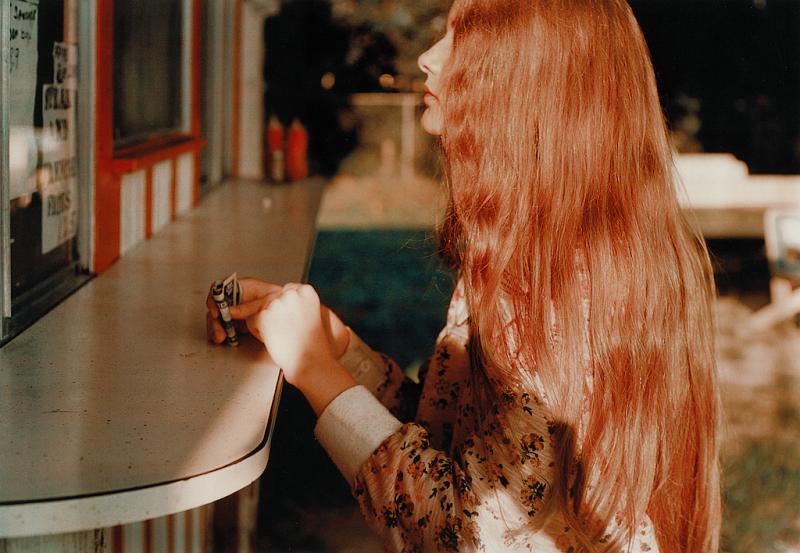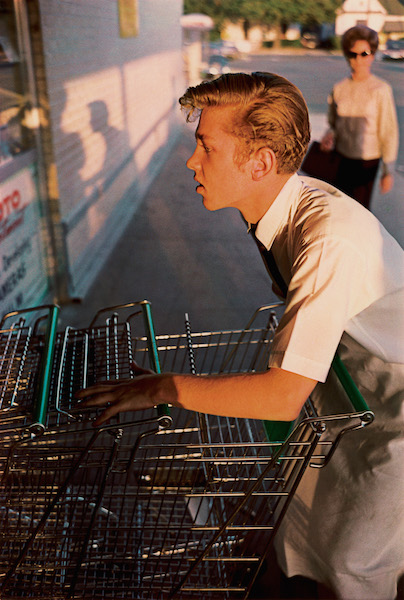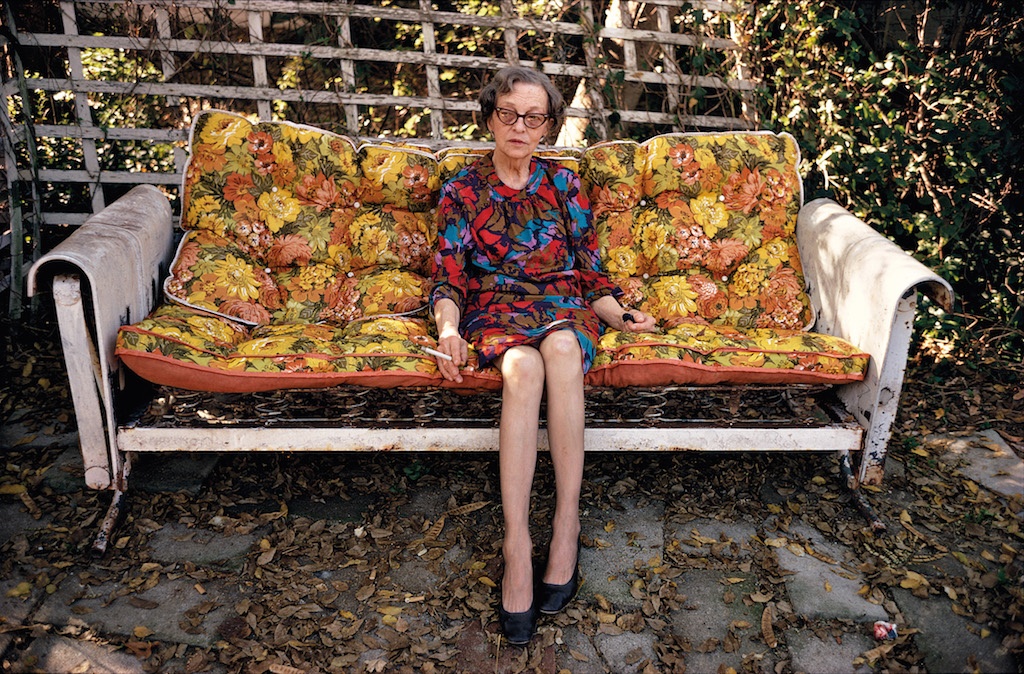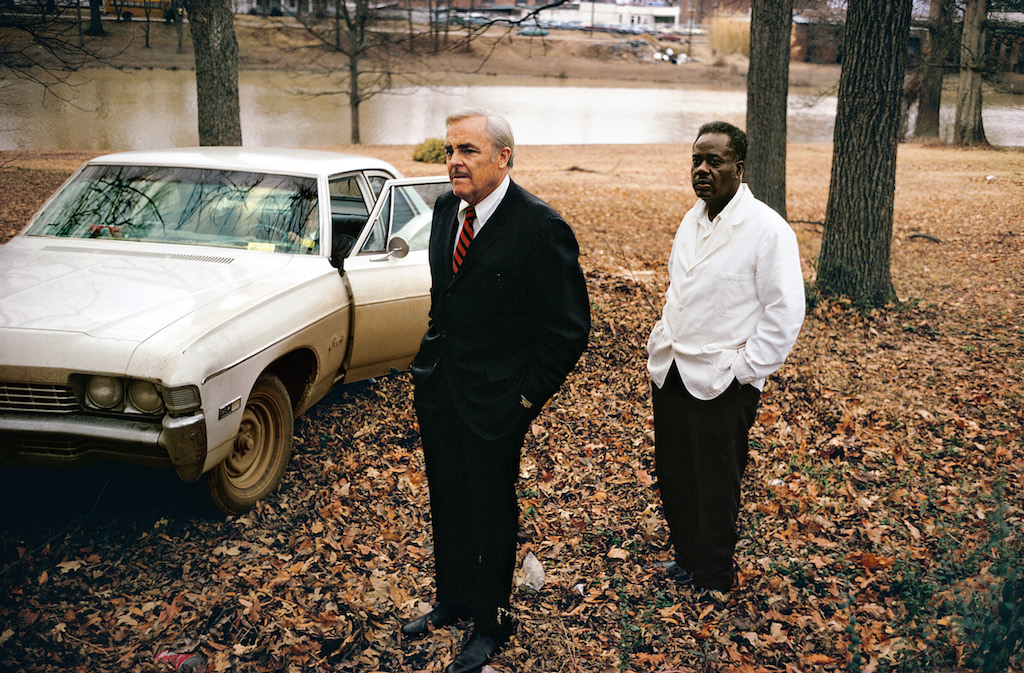William Eggleston Portraits, National Portrait Gallery | reviews, news & interviews
William Eggleston Portraits, National Portrait Gallery
William Eggleston Portraits, National Portrait Gallery
The American who made colour photography an art form

American photographer William Eggleston is famous for dedicating himself to colour photography at a time when it was still considered kitsch – acceptable for wedding and Christening photos, but not much else. The best known example of his embrace of colour is a 1973 photo of a red light bulb hanging from a red ceiling, a picture devoid of subject matter beyond redness and the associations it triggers.
You could almost say the same of a photograph he took the following year of a young woman at a fast food counter in Biloxi, Mississippi (main picture). We see her from the side waiting expectantly for her order, oblivious of the camera. Cascading over her shoulders, her red hair hides most of her face. Glowing in the evening light, it looks almost on fire compared with her pale skin, oatmeal dress and the beige counter on which she is leaning.
 Of The Red Ceiling, Eggleston said, “it's like it's red blood that is wet on the wall. The photograph was like a Bach exercise for me because I knew that red was the most difficult color to work with. A little red is usually enough, but to work with an entire surface was a challenge. It was hard to do. I don't know of any totally red pictures, except in advertising.”
Of The Red Ceiling, Eggleston said, “it's like it's red blood that is wet on the wall. The photograph was like a Bach exercise for me because I knew that red was the most difficult color to work with. A little red is usually enough, but to work with an entire surface was a challenge. It was hard to do. I don't know of any totally red pictures, except in advertising.”
If the challenge of the ceiling was a formal one, what might be said of Untitled? Again the pleasure is visual; the girl’s auburn hair sets this ordinary scene alight with its fiery undulations. There’s no storyline or emotional engagement – just the delight of beauty spotted in banal circumstances.
Eggleston claims to photograph a person in the same way he does a parking lot. “I had this notion of what I called a democratic way of looking around, that nothing was more or less important”, he has said. “I’ve never been a bit interested in the fact that this was a picture of a blues musician or a street corner or something... I just take the picture.”
For most people, “just taking the picture” would result in tedious clichés, but Eggleston has an uncanny knack of spotting those sublime moments when random elements cohere to make the ordinary seem strange or beautiful. Ironically, its when he takes what might be described as traditional portraits – isolating a subject and focusing in on his or her face – that the results tend to be unexceptional.
Instead of intimate encounters, he specialises in treating everyone as a stranger. Even when the sitter is known to him, his pictures of people remain Untitled, because his interest lies not in a person’s individual identity so much as their place in the world. The most memorable of his superb images are of people in an environment; and something about the mise en scene triggers one’s curiosity and arouses one’s empathy.
In Untitled, 1965 (Memphis, Tennessee) (pictured above right), the important detail is the golden light catching the boy’s blond quiff, face, shirt and arm as he shunts a line of shopping trollies through a supermarket door with great concentration. Behind him, out of focus, is an approaching shopper. She has a walk-on role, except that in the shadows cast on the supermarket wall, the roles are reversed. She appears closer and dwarves his hunched form. The joke is that their shadows fit together as neatly as jigsaw pieces.
The comedy is always visual. Untitled, 1965-8 (Memphis, Tennessee) features two people sitting opposite one another on the green banquettes of a diner. We are positioned behind the woman in such a way that, cresting like a wave, her enormous French twist blots out her companion’s face. We can glean nothing of their interaction except from their hands and elegantly held cigarettes.
 Devoe Money (pictured above) sits hunched on a grounded swing; her slight figure seems hemmed in by the busy patterning of her dress, the cushions, the trellis behind, the surrounding bushes and the fallen leaves. Everything in the picture is in decay; entropy reigns.
Devoe Money (pictured above) sits hunched on a grounded swing; her slight figure seems hemmed in by the busy patterning of her dress, the cushions, the trellis behind, the surrounding bushes and the fallen leaves. Everything in the picture is in decay; entropy reigns.
By contrast, the young black woman walking towards us across an apparently endless plane near Minter City and Glendora, Mississippi looks lost in space. Her lime-green dress echoes the grasses blowing at her feet, while her headscarf matches the puffy clouds. Standing beside a strip of concrete road almost at the vanishing point of the composition, she forms a pivotal link between sky and ground. What, though, is she doing on foot in the middle of nowhere?
A gathering storm creates the strangely intense atmosphere of Eggleston’s 1973 photograph of his son, William. Dressed in an oddly shaped red cardigan that makes his arms look as if they are dangling, the young boy seems hunched against the wind. Behind him is a line of telegraph poles from which his body appears to be suspended, like a hanged man.
Eggleston’s best photographs are decidedly cinematic. A narrative seems about to unfold and the outcome is uncertain. A photo of two men standing on dead leaves, beside a white car with its doors open (pictured below Untitled 1969-70 in Cassidy Bayou, Sumner, Mississippi), is redolent of a spy story. Stoney-faced and with hands in their pockets, they are watching something unpleasant – an execution, maybe?
In fact, the story lies elsewhere – in the relationship between the two men, who are at a funeral. For decades the black man, Jasper Staples, has been chauffeur and assistant to the white man, Eggleston’s uncle, Adyn Schuyler Senior; in that time he has come to resemble his employer so closely that he unconsciously mimics his facial expression, posture and stance in almost every detail. Unwittingly perhaps, the photograph is a meditation on master/servant relations.
 In one sense, Eggleston’s photographs of people are not portraits at all, since he doesn’t even attempt to enter the private worlds of his subjects. I was going to write sitters, but people rarely pose knowingly for his pictures; more often the photographer spots them in the street, the diner, the parking lot or their place of work and catches them in situ – embedded, as it were, in the place where they have their being.
In one sense, Eggleston’s photographs of people are not portraits at all, since he doesn’t even attempt to enter the private worlds of his subjects. I was going to write sitters, but people rarely pose knowingly for his pictures; more often the photographer spots them in the street, the diner, the parking lot or their place of work and catches them in situ – embedded, as it were, in the place where they have their being.
Collectively, then, his pictures form a portrait not of individuals, but of social relations in America’s deep south – where people seem to know their place, yet at the same time, appear fundamentally alone.
- William Eggleston Portraits at the National Portrait Gallery until 23 October
- Read more visual arts reviews on theartsdesk
rating
Share this article
Add comment
The future of Arts Journalism
You can stop theartsdesk.com closing!
We urgently need financing to survive. Our fundraising drive has thus far raised £49,000 but we need to reach £100,000 or we will be forced to close. Please contribute here: https://gofund.me/c3f6033d
And if you can forward this information to anyone who might assist, we’d be grateful.

Subscribe to theartsdesk.com
Thank you for continuing to read our work on theartsdesk.com. For unlimited access to every article in its entirety, including our archive of more than 15,000 pieces, we're asking for £5 per month or £40 per year. We feel it's a very good deal, and hope you do too.
To take a subscription now simply click here.
And if you're looking for that extra gift for a friend or family member, why not treat them to a theartsdesk.com gift subscription?
more Visual arts
 'We are bowled over!' Thank you for your messages of love and support
Much-appreciated words of commendation from readers and the cultural community
'We are bowled over!' Thank you for your messages of love and support
Much-appreciated words of commendation from readers and the cultural community
 Lee Miller, Tate Britain review - an extraordinary career that remains an enigma
Fashion photographer, artist or war reporter; will the real Lee Miller please step forward?
Lee Miller, Tate Britain review - an extraordinary career that remains an enigma
Fashion photographer, artist or war reporter; will the real Lee Miller please step forward?
 Kerry James Marshall: The Histories, Royal Academy review - a triumphant celebration of blackness
Room after room of glorious paintings
Kerry James Marshall: The Histories, Royal Academy review - a triumphant celebration of blackness
Room after room of glorious paintings
 Folkestone Triennial 2025 - landscape, seascape, art lovers' escape
Locally rooted festival brings home many but not all global concerns
Folkestone Triennial 2025 - landscape, seascape, art lovers' escape
Locally rooted festival brings home many but not all global concerns
 Sir Brian Clarke (1953-2025) - a personal tribute
Remembering an artist with a gift for the transcendent
Sir Brian Clarke (1953-2025) - a personal tribute
Remembering an artist with a gift for the transcendent
 Emily Kam Kngwarray, Tate Modern review - glimpses of another world
Pictures that are an affirmation of belonging
Emily Kam Kngwarray, Tate Modern review - glimpses of another world
Pictures that are an affirmation of belonging
 Kiefer / Van Gogh, Royal Academy review - a pairing of opposites
Small scale intensity meets large scale melodrama
Kiefer / Van Gogh, Royal Academy review - a pairing of opposites
Small scale intensity meets large scale melodrama
 Jenny Saville: The Anatomy of Painting, National Portrait Gallery review - a protégé losing her way
A brilliant painter in search of a worthwhile subject
Jenny Saville: The Anatomy of Painting, National Portrait Gallery review - a protégé losing her way
A brilliant painter in search of a worthwhile subject
 Abstract Erotic, Courtauld Gallery review - sculpture that is sensuous, funny and subversive
Testing the boundaries of good taste, and winning
Abstract Erotic, Courtauld Gallery review - sculpture that is sensuous, funny and subversive
Testing the boundaries of good taste, and winning
 Edward Burra, Tate Britain review - watercolour made mainstream
Social satire with a nasty bite
Edward Burra, Tate Britain review - watercolour made mainstream
Social satire with a nasty bite
 Ithell Colquhoun, Tate Britain review - revelations of a weird and wonderful world
Emanations from the unconscious
Ithell Colquhoun, Tate Britain review - revelations of a weird and wonderful world
Emanations from the unconscious
 Rachel Jones: Gated Canyons, Dulwich Picture Gallery review - teeth with a real bite
Mouths have never looked so good
Rachel Jones: Gated Canyons, Dulwich Picture Gallery review - teeth with a real bite
Mouths have never looked so good

Comments
Surely the taller shadow on
Surely the taller shadow on the wall in Untitled, 1965 (Memphis, Tennessee) is that of Eggleston himself, in the act of taking the picture. The shadow of the woman in the middle distance couldn't possibly cross that of the young man in the foreground when the sun is behind the photographer's right shoulder. The joke of the "jigsaw" fit is then perhaps something to do with the relation between artist and subject.